Wings of Destiny Gave Listeners Their Own Planes
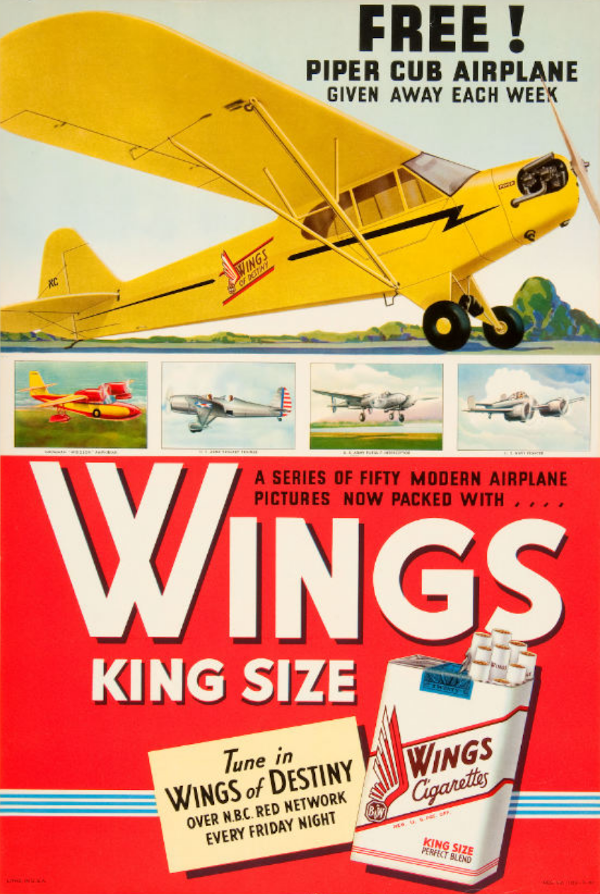
Did it ever occur to you to wonder what you'd do if you won one of those midget airplanes the Wings of Destiny program gives away every week? Of course it's nice to get the plane, but it really isn't easy to take care of it. As Mrs. Thomas Frissell of Middletown, Connecticut, one of the winners exclaimed, "You can't just put an airplane under the bed!"
Mrs. Frissell was so excited when she got the telephone call telling her she'd won a plane that she lost her voice. Then she recovered and rushed out to the local airport to rent a hangar and take out insurance. She didn't keep the plane, though. She doesn't drive a car very well, and she'd heard pilots say that unless you were able to drive a car you probably would have trouble learning to pilot a plane.
So she accepted one of her 16 offers and sold her Piper Cub for $1,300. Only two other winners have sold their prizes -- George Blair of Miami and Harold Beck of Lebanon, Indiana. Beck wanted the money for an operation his son needed, and Blair wanted to build a house.
Some of the Wings winners have been inspired to become full-fledged pilots. One is Albert Walker of Pueblo, Colorado; another is Victor Boudin of Houston. V.J. Sweeney of Chicago already knew how to fly, so he arranged for his wife to take the lessons that are included as part of the prize. Henry Miller of Tulsa, Oklahoma, found his prize very appropriate -- he works at the Spartan School of Aeronautics. Lieutenant Wyan Thiessen of Davenport,Iowa, found his far from appropriate -- he's a Reserve Cavalry Officer. But he's a flying enthusiast now.
Thomas Gallagher of Norwood, Ohio, makes his plane work for him. He rents it out at the local airport to students who don't own planes of their own.
Dan Senseney in Radio Mirror, May 1941
Lanny Grey Conducts the Rhythm School of the Air
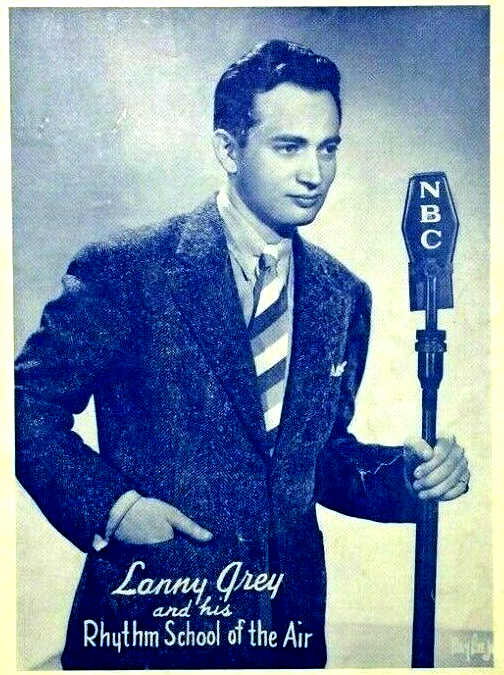
Lanny Grey, young NBC singer, pianist and arranger, is going to see his name in big Mazda lights one of these days, if I'm a judge, because he has the certain priceless ingredients that help mold great stars.
He concocted an idea, Rhythm School of the Air -- something just a little different -- and you can hear it any Thursday at 6:30 p.m. Eastern time -- and he's going to sink or swim with it.
It's just a sustainer now and by the time Lanny pays out his small cast, he's got just enough left to buy a copy of Variety and grab a sandwich in the Radio City drugstore. But he's not worrying. You even believe him when he candidly tells you that he never took a piano lesson in his life and even today can't read a note of music!
His little program is all his own idea. The entire show is done in rhyme and there are no spoken words. Lanny plays the piano and arranges all the numbers. He has perfected a system of signs instead of the customary musical notes. Lanny studies the new tunes at the publishers, memorizes them, then coaches Judy, the Sing-Sing Sisters, the Rhythm School Quartet, Mary McHugh, Jimmy Rich, Nursery Crime Detective and Don Richards.
It takes him a week to get the show perfected, but only a half hour to remember a tune.
The cast is not as imposing as it sounds.
"You see the Sing-Sing Sisters are really Judy and Mary. The Rhythm School Quartet is composed of Jimmy, Judy, Mary and myself. Jimmy Rich the organized doubles as the Nursery Crime Detective, and the other 12 characters on the show are divided among the five of us," explained the University of Pennsylvania graduate.
The kids on the show are sticking with Lanny until sponsorship offers come his way. They have turned down several flattering individual contracts. They're placing their bets on Lanny.
:Any guy that can pick up the ukulele, learn the chords, then master the banjo, and finally the piano, without even a metronome in the house, can do anything," is the way partner Judy sums it all up.
At nights they usually get together at Lanny's apartment to concoct the big commercial idea that they think the show still lacks before it can go bigtime.
Ken Alden in Radio Mirror, November 1938
The DeZurik Sisters, Yodelers on the National Barn Dance
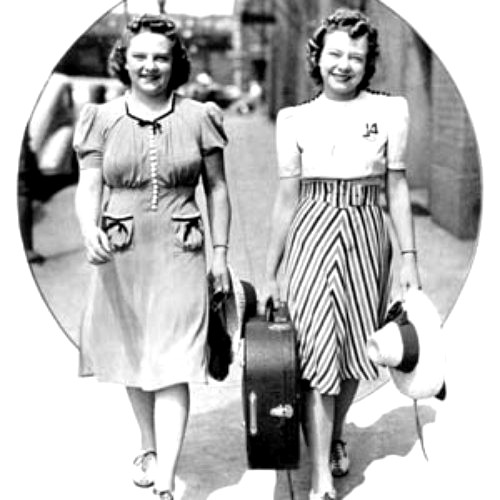
Just a little more than three years ago a couple of blond, blue-eyed sisters up in Royalton, Minnesota, decided they'd learn to sing. neither of them had ever sung a note and they didn't know the first thing about playing any musical instrument -- but that didn't stop them. They got to work on the song, "Will the Angels Play Their Harps for Me?" and discovered to their surprise that their voices sounded pretty good.
After they had practiced a few more songs, they decided to try their hand at playing a guitar. The reason they chose a guitar rather than any other musical instrument was that their brother was the proud possessor of a brand-new guitar. He didn't especially favor the idea of having his sisters experimenting with it, but they managed to do quite a little practicing while he was out of the house. It wasn't any time at all until their playing was the talk of the town.
A lot of girls might have stopped there and rested on their laurels -- but not Caroline and Mary Jane DeZurik. They decided to learn to yodel. The only question was how to go about learning an art that's so little known. Imitating the best yodelers seemed the best solution. The first yodel song was the "Alpine Milk Man." The had heard it many times on the WLS National Barn Dance and they tried to make their yodels sound as much as possible like the radio variety.
The next step in their musical career was their invention of the "double-yodel" with which their radio listeners have since become familiar. Last fall they entered an amateur contest in Little Falls, Minnesota, and won it. Then they went on to another contest in St. Cloud, Minnesota. They won that one, too, and it just happened that a bunch of the WLS folks who were making a personal appearance in Minnesota heard them sing and invited them to guest appear on their program. About a month later they joined the WLS staff, after having broadcast a few times from the station KSTP in St. Paul.
Last month the DeZurik sisters appeared in St. Cloud, which is only about 25 miles from their home town, Royalton. Pat Buttram had just introduced them to the theatre audience and they were standing before the mike, ready to sing, when a band started playing. More than half of Royalton's population of 500 -- complete with the town band -- had driven in to St. Cloud to hear the girls sing and to give them a rousing welcome. In the audience was the entire DeZurik family, Mr. and Mrs. DeZurik and Ethel, Eva, Lorraine, Delphine and Jerome.
Caroline, who is 18, and Mary Jane, 20, live in Chicago with their cousins. They girls are exceedingly modest about their accomplishments and their greatest ambition is to compose music. Neither of the sisters is married. Mary Jane is exactly five feet tall and Caroline is five feet one. Their favorite pastime is hunting or fishing.
From Stand By, September 11, 1937
John Hodiak: From Hamtramck to Hollywood
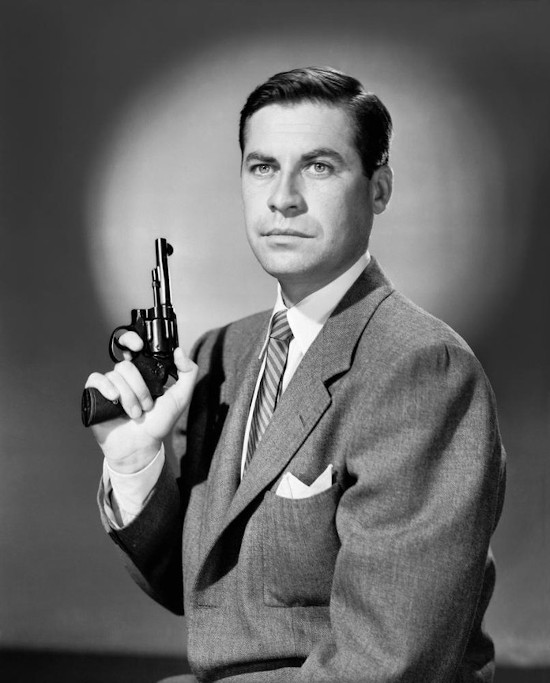
It was the church plays, the high school dramas and John Hodiak's eagerness to spout speeches that got him hipped on the radio acting idea which finally paid off way out in Hollywood. Hodie had worked up such an oratorical rep around Hamtramck that when a campaigning candidate for Michigan's governorship hit Hamtramck, he stumped the place for him and got votes galore.
"When I'm elected, son," promised the grateful statesman, "let me know what I can do for you."
Hodie wasn't backward. He let him know all right. He was just out of high school. His dad was just out of a job. Both were out of money. He wrote the new governor. "Please (1) get my dad a job. (2) Give me a recommendation as a speaker. I want a radio job."
The gov came through, Pop got on the payroll at a Depression-stalled plant, and Hodie got a glowing build-up as the silver-tongued young orator of the century. But the program director of Detroit's biggest station was not impressed. "Let's hear you read," he sighed.
Hodie gave out with what he considered deathless oratory, but the neighborhood dialects of all the Polettis, Wojiehowiczes, Schmaltzes and Garfinkels ganged up on him. His Hamtramck accents smote the mighty radio man definitely in the wrong acoustical places.
"Take some good advice, kid," he told 18-year-old Hodie. "Go home, get a job in a factory, marry a nice girl and forget this radio acting stuff. You sound like the Melting Pot of the West going East!" His attitude was, "Go away, boy, you bother me!"
Well, it still makes John Hodiak red in the face to talk about that episode. But he's fair enough now to admit that those caustic comments were not only gospel, but exactly what stung him on to success.
But to Hodie, that radio man's bop on the ego could never be soothed until he did something about it. So he ironed out his diction by reading aloud and talking to every college-educated man at Chevrolet (where he'd gotten a $45 a week job in the meantime) until he had his vowel tones rolling right in the groove.
When another Detroit station staged a competitive audition, Hodie won it hands down. Toot de suite he wrote a very snooty letter to the program chief who'd insulted his ambitions. He enclosed the newspaper clipping announcing his audition triumph. Then he felt a lot better. He got just as snooty a note back, telling him he was probably still lousy. But it ended, "Come and see me."
That started Hodie's radio career. They sort of adopted him around the station, shoved him into this and that show in bit lines, mob murmurs and extra parts. But always at night after his regular job. Pretty soon they wanted him days, too, and the Great Decision loomed. The offer: "Put you on the studio acting staff -- salary, $35 a week." Hodie's spot: He was already making $45 at Chevrolet. So what did he do? He quit and took the radio job.
Well, even Hodie's folks couldn't understand that. Pop and Mom Hodiak and his brother and sis thought he was stark and raving. Hodie was about 21 then, and already Pop had said, "Now son, it's time you got yourself married to a nice girl You can move into the attic rooms, have scads of kids and live with us." Hodie was already a catch; he had a cushy office job at the plant with a fabulous salary. Here he was tossing away his future for $10 less! Ten dollars has always been plenty of dough in Hamtramck.
But that was the last peep of protest Hodie ever got from his folks or neighbors. Pretty soon he was on The Green Hornet and The Lone Ranger shows and a celebrity in the neighborhood. Even afterwards Hodie was always a hero to the hometown folks, and many's the time Mom and Pop sent on a $5 bill they'd borrowed down the block to help over the rough spots.
Well, to tuck up a long tale, Detroit radio soon got too small for Hodie, even though he was dragging down $75 a week. He moved on to Chicago, struck it rich the first week, went broke thereafter, lived high, starved low by turns, but made a name for himself in the gang of soap operas and radio action thrillers the Windy City has always scattered out on the groaning air. Ma Perkins, Girl Alone, Mary Marlin, Wings of Destiny. His biggest break was playing Lil' Abner on the air.
When the Hamtramck homefolks heard Hodie spouting Dogpatch talk on that one, by the way, they wrote him real puzzled, "What's happened to you? You don't sound like yourself." Nobody there ever has thought of him as an actor -- just as Hodie Hodiak, the kid down the street.
Eventually, what had happened to Don Ameche and Tyrone Power and a bunch of other radio actors around Chicago happened to Hodie. It's almost routine when a guy makes good in Chicago radio that he gets a Hollywood test if he wants it -- that is, if he doesn't have bow legs and a squint.
Jack Wade in Modern Screen, February 1945
Sandy Becker, Young Announcer with an Old Voice
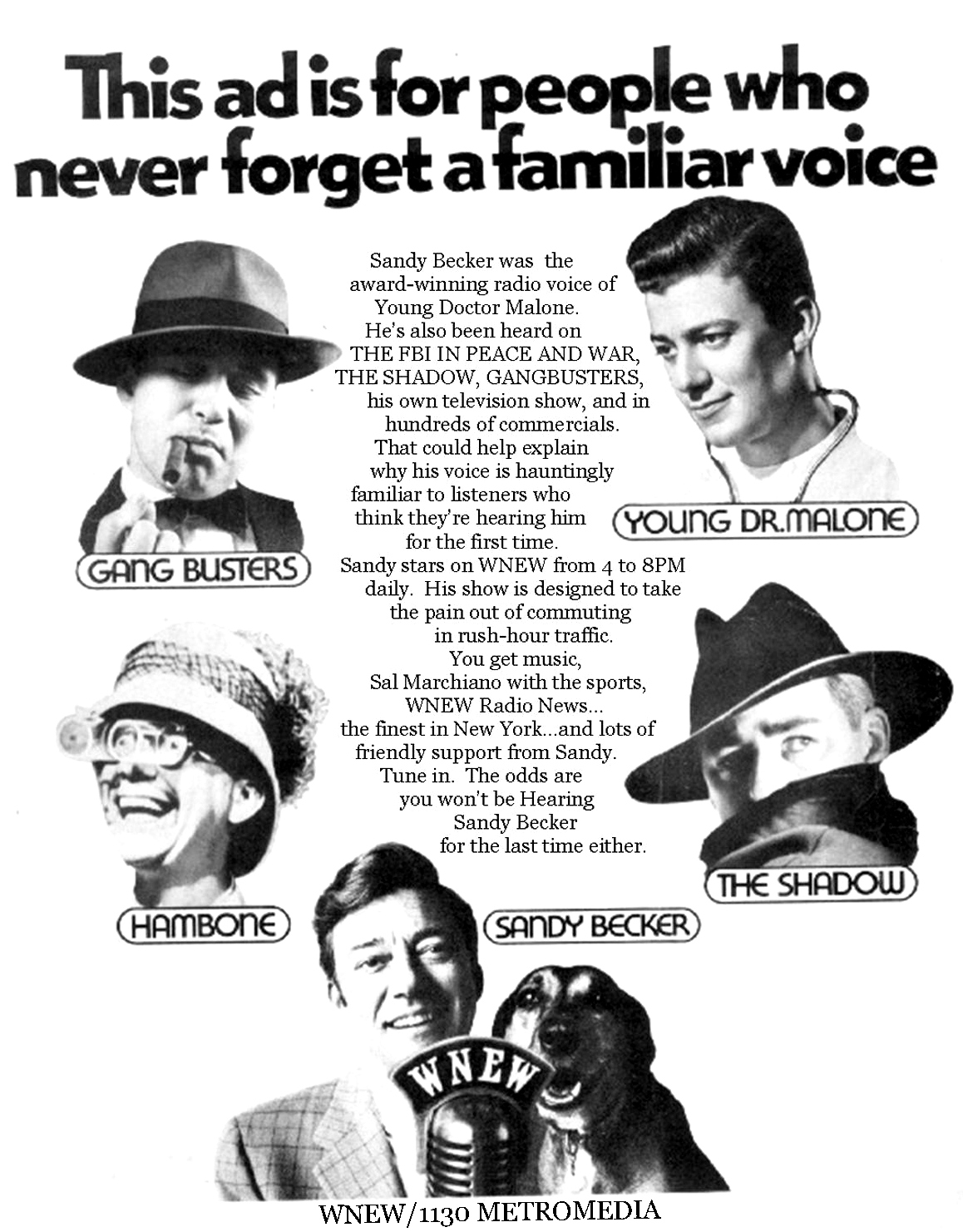
Radio listeners are getting accustomed to learning that their favorite air personalities don't look like their voices sound. But Carolinians can't quite hide their amazement when they see Sandy Becker, WBT announcer.
Sandy tips Father Time's scales at 22 but to hear his voice you'd expect the years to hang heavy on his shoulders. It is a booming, full voice that sounds as though its owner had spent years training it to perfection. It's a voice filled with expression, emotion and worldliness. Yet Sandy Becker has never traveled farther from his birthplace of New York City than Charlotte, and his face is young and unlined.
Once when he was announcing a children's program, he invited listeners to send their children to the studio for an air appearance. Mothers and children alike were stunned to find that their "Uncle Sandy" had no long gray beard for them to trip over.
Sandy started his dramatic career as the builder and producer of a puppet show at the age of 10. All by himself, he did the voices of his 12 puppet characters. In college, he found radio irresistibly attractive and left school to take a job on a small New York station. He hadn't been there long before his fine voice was brought to the attention of Charles Crutchfield, WBT program director, who invited him to join the WBT announcing staff.
Along with Sandy's regular announcing duties, he presents Poet's Music -- a title he originated -- at 11:30 a.m. every Sunday morning. With recorded classical music as a background, he reads poems that blend best with this type of accompaniment; and sometimes he reads poems of his own composition. His audience on this program is so big that sometimes letters come in from as far away as Ohio and New York. Many of the letters ask him to read certain poems, and he always complies if he can.
When Sandy isn't announcing, he is forever lobbying for his host of hobbies -- the most important of which are cartooning, sculpturing, sketching, tennis and swimming. He's on the verge of giving up the dubious advantage of being WBT's only bachelor announcer. He has announced his intention to marry a young lady who is one of Charlotte's loveliest debutantes.
Dale Banks in Radio Mirror, June 1942
Lone Ranger's Lost Treasures of the West
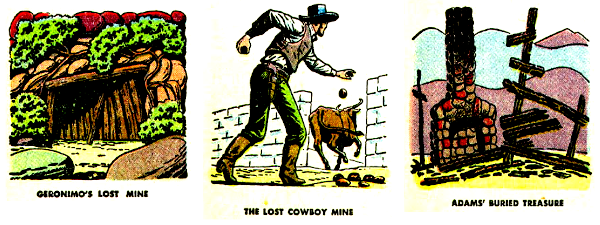
Geronimo's Lost Mine
After a disastrous fight with the U.S. Army, Geronimo, the great Apache warrior chief, found himself imprisoned in the stockade at Fort Sill. He told one of his guards of a fabulous mine where the Apaches mined the "green bads" that they used for ornaments -- and where they mined their gold.
The guard promised to help the Chief escape if the Indian would guide him to the mines. But the plot was later discovered and the guard was sent to prison. Later, Geronimo himself was exiled to a reservation in Florida, far from his secret mine. Even today, prospectors search for the mines of the Apaches.
The gold mine is said to be located in the bottom of a deep box canyon near an old adobe house. The Apaches regularly traded gold for guns and ammunition, food, and clothing. The mine must have been very rich, but to this date remains undiscovered.
The Lost Cowboy Mine
About 60 years ago, an old corral stood on the banks of the Colorado River north of Yuma, Arizona. It was built of adobe blocks. Cowboys used it to gather wandering steers until they could muster enough cowpunchers to drive a herd back to their home ranches. Near the corral was a low round hill covered with black, rounded pieces of heavy stone or metal. The cowboys often threw the stones at the half-wild steers to frighten them through the corral gate.
Gradually, as permanent settlers came into the territory, the corral was abandoned. One of the cowboys went back East to his childhood home and took a few of the strange, heavy stones with him. Years later, a friend of his who was a mining expert examined them and discovered that they were almost pure lumps of solid gold, although tarnished black due to long exposure to the weather.
Since then, hundreds of people have tried to find the Lost Cowboy Mine and its acres of gold nuggets. None have succeeded. Either the old corral was gradually washed away by stones, or someone secretly destroyed it to conceal the mine's location.
Adams' Buried Treasure
Many years ago a man named Adams and six others discovered a rich mine near the headwaters of the Gila River in Arizona. They built a small cabin and worked the mine hard. Their greatest danger lay in being discovered by the raiding Apaches.
One day, Adams and one of his partners left the camp for town. The first night they camped on a high hill and looked back toward the mine. The cabin was in flames and the blaze of gunfire lit the surrounding sky. The Apaches had killed all their friends. After struggling on for many miles across the desert, the two men were discovered, half-starved and in a delirious state.
Adams' partner was killed a short time later. For years, Adams could not re-enter the territory which was rampant with hostile Indians. When he finally went back after many years, he was unable to locate the mine. His landmark, the cabin, had been completely destroyed. There must be $600,000 worth of gold buried under the site of the cabin.
From Lone Ranger's Golden West, 1955
When Wendell Niles Moved to Pine Ridge, Arkansas
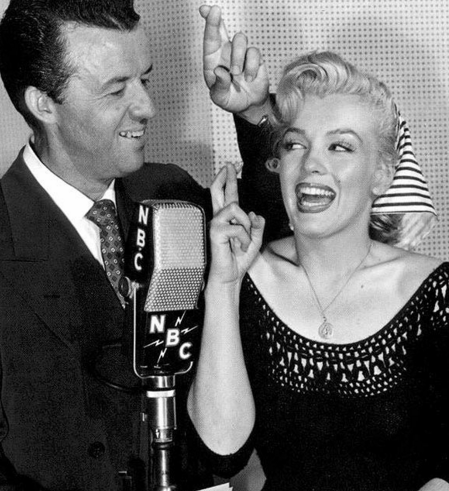
Radio announcer Wendell Niles worked on several radio series at one time; by the 1939-40 radio season he was featured on not only the Al Pearce Show, in which the rotund comedian Pearce portrayed Elmer Blurt, a reticent door-to-door salesman ("Nobody home, I hope I hope I hope"), but also on Gene Autry's brand-new Melody Ranch program (for "healthful, refreshing Doublemint Gum.").
By 1942, Niles had landed his longest-running stint, with The Pepsodent Show, starring Bob Hope. During those wartime years, Niles, Hope and the rest of the cast (Frances Langford, Barbara Jo Allen as Vera Vague and the zany Jerry Colonna) traveled to military bases worldwide to entertain the troops and help the war effort.
Around this same period of time, Niles and his very good friend Don Prindle gained quite a bit of fame as the comedy team Niles and Prindle, appearing in movies and in their own radio series for several years. After the war, Niles worked on many more programs both with and without Prindle, along the way changing his billing from Wen Niles to Wendell Niles in a further attempt to avoid confusion with his brother, who by now was well-entrenched on the Abbott and Costello program, among many others.
In 1946, Niles announced for Hollywood Startime (a clone of Lux Radio Theatre), which was sponsored by Frigidaire. This led directly to his hooking up with Lum and Abner when Frigidaire began sponsoring the new half-hour Lum and Abner Show in September 1948. In addition to announcing, Niles also appeared as himself in the body of each program, although it was never fully explained just what famed radio announcer Wendell Niles was doing living in Pine Ridge, Arkansas! Most often he appeared to be a local Frigidaire representative, checking on how his products were moving in the Jot 'Em Down Store. Niles remained with Lum and Abner through the end of their second and final half-hour season in 1950.
From Jot 'Em Down Journal, August 1989
Top 10 Articles
- The Marriage of Don Ameche and Honore Prendergast
- The Night Arthur Godfrey Fired a Singer On Live Radio
- Early Radio Announcers Invented Their Profession in the 1920s
- The Mythical Town of East Tincup, Colorado
- The Earliest Radio Shows of the 1920s
- The Great Radio Detectives of the 1950s
- The Home Life of Jack Benny
- Why Vladimir Horowitz Stopped Performing in the 1930s
- Judy Canova: The Queen of Hillbilly Hokum
- Some of the Unsung Heroes of Radio

